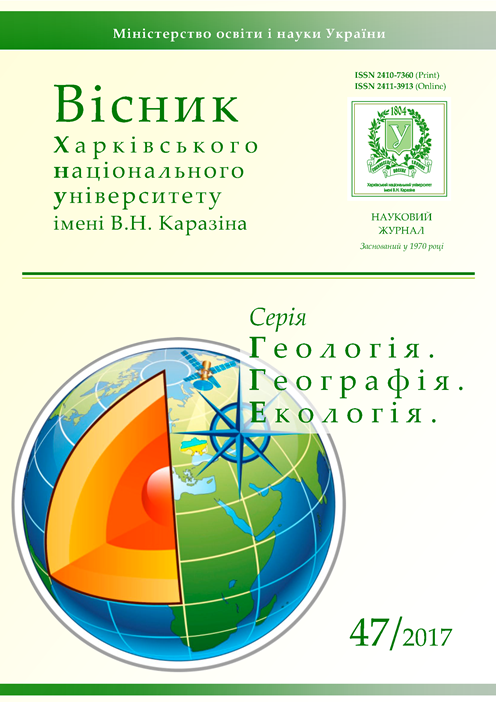Physical and geographical principles of tourist cluster’s formation in Kharkiv region
Abstract
Formulation of the problem. The article considers the main physical and geographical factors (climate, water, forest, relief) forming a tourist cluster on the territory of Kharkiv region. The cluster approach allows us to determine priority directions for the development of tourism, to use natural conditions as much as possible and to carry out nature conservation measures.
The purpose of the article. The purpose of this article is to study natural-geographical criteria for the formation of the tourist cluster in Kharkiv region, their evaluation and generalization.
Methods. The study of climatic parameters has been carried out using a statistical method, analyzing time series of average monthly air temperature, precipitation and solar radiation for the period 2001-2015.
Results. Given the fact that Kharkiv region is in the northeast of Ukraine, it is characterized by a peripheral location. In general, its area is approaching a circle, determining equivalent relations between the regional center and the outskirts.
The relief of Kharkiv region is mostly undulated, it is a plain, cut by river valleys, valley floors and power ravines. The peculiarities of the terrain in the region are emphasized by burial mounds (graves) created by man in ancient times, which increases historical and cultural value of the region under study. Climatic resources of Kharkiv region are favorable for recreation, especially for summer types, such as beach, sports, cognitive recreation.
According to N. Fomenko’s methodology of estimating the recreational territory, the climatic resources of the studied region correspond to the indicator "good", as well as to the parameters of optimal climatic conditions for recreational purposes. The territory of Kharkiv region is located in two landscape zones - the forest-steppe (northern part of the region) and the steppe (southern part). Today steppe vegetation has almost disappeared, which is explained by excessive agricultural activity. Kharkiv region is one of the main centers of balneotherapy on the left bank of Ukraine.
Scientific novelty and practical significance. Today, the tourist cluster is considered an innovative form of the regional economic development, since tourism is one of the territory’s socio-economic functioning factors. Tourist and recreational activities are also very important in international economic relations. The formation of the tourist cluster of the territory will make it possible to effectively use all available tourist and recreational resources of the territory. Thus, the main factors determining the organization of tourist and recreational activity on the territory of Kharkiv region are relief, climate, water and vegetation resources. The region under study has sufficient recreational and tourist resources and good potential for their development, primarily of cognitive, river recreational, green and ecological tourism.Downloads
References
2. Бунаков, О. А. Кластерный подход к позиционированию в туризме // Управление экономическими система-ми: электронный научный журнал, 2011. – № 4 (28). – [Електронний ресурс]. – Режим доступу : http://uecs.mcnip.ru.
3. Гончарова, Л. Д. Клімат і загальна циркуляція атмосфери / Л. Гончарова. – К. : КНТ, 2005. – 351с.
4. Дишловий, І. М. Питання формування та функціонування кластерів у рекреаційно-туристичному комплексі регіону / Дишловий І. М. // Економічні інновації. – 2011. – Вип. 44. – С. 79-89.
5. Климатологические стандартные нормы (1961 – 1990 гг.). – К., 2002. – 446 с.
6. Портер, М. Е. Международная конкуренция: Конкурентные преимущества стран / М. Е. Портер. – М. : Международные отношения, 1993. – 105 с.
7. Решетченко, С. І. Зміни середньомісячної температури повітря та опадів за період 1951-2010 рр. у Харкові / С. Решетченко, О. Бабаєва // Проблеми безперервної географічної освіти і картографії: зб. наук. праць. – Харків : ХНУ імені В.Н. Каразіна, 2013. – Вип. 18. – С. 142-145.
8. Решетченко, С. І. Особливості динаміки атмосферних явищ на території Харківської області / С. Решет-ченко, М. Христосов // Проблеми безперервної географічної освіти і картографії : зб. наук. праць. – Харків : ХНУ імені В. Н. Каразіна, 2017. – Вип. 26. – С. 61–66.
9. Соколенко, С. І. Розвиток економіки регіонів на основі інноваційних кластерів / С. І. Соколенко // Інве-стиційно-інноваційний розвиток економіки регіону : Мат. IV з’їзду Спілки екон. України. – К. : Навчальна книга – Богдан, 2010. – С. 100–106.
10. Стеченко, Д. М. Наукова сутність процесу кластеризації в сфері туризму / Д.М. Стеченко // Вісник Хмель-ницького інституту регіонального управління та права. – 2004. – № 1–2. – С.376 –380.
11. Ткаченко, Т. І. Сталий розвиток туризму: теорія, методологія, реалії бізнесу: монографія / Т. І. Ткаченко. – 2-ге вид., випр. та доповн. – К. : КНТЕУ, 2009. – 463 с.
12. Требух, А. А. Туристичний кластер як форма посилення конкурентних переваг регіону / А. Требух, Н. Бандура // Науковий вісник НДТУ України. – 2010. – С. 265-270.
13. Туристичний кластер Харківщини. Монографія / Колектив авторів, заг.ред. О. Яковчук. – Харків : РВВ ХТЕІ КНТЕУ, 2017. – 400 с.
14. Фоменко, Н. В. Рекреаційні ресурси та курортологія / Н. Фоменко. – К. : Центр навчальної літератури, 2007. – 312 с.





